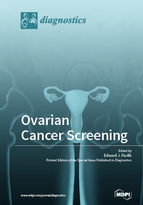Ovarian Cancer Screening
A special issue of Diagnostics (ISSN 2075-4418). This special issue belongs to the section "Pathology and Molecular Diagnostics".
Deadline for manuscript submissions: closed (30 June 2017) | Viewed by 119820
Special Issue Editor
Interests: ovarian cancer; cancer screening; tumor imaging
Special Issues, Collections and Topics in MDPI journals
Special Issue Information
Dear Colleagues,
Ovarian cancer is deadly, claiming more women than all other gynecological malignancies combined. However, when detected at an early stage ovarian cancer is highly curable. Consequently, screening efforts are likely to be the best way to detect early stage disease. The forthcoming Special Issue focuses on several key elements that are essential for an understanding of ovarian cancer screening:
- Screening trial design, make-up and execution. Considerations must choose a design that is protocol driven vs. a random control trial, age of participants, periods for screening and follow-up and events to be censored.
- Treatment of women identified by screening. Time to treatment must be minimized so that an early stage detect is not permitted to progress to an advanced stage. Importantly, treatment must be optimized for the best possible outcomes by utilizing gynecologic oncologists.
- Collateral affectors in screening. Both perceptions of well being and potential complications of treatment should be considered as confounders of compliance.
- Endpoints and efficacy. Early stage detection, disease specific survival, overall survival and avoidance of an ovarian cancer death can each be considered as an endpoint, Considerations of screen performance and cost determine efficacy.
- Interpretation of ovarian screening trials. Comparisons between screening trials conducted in the United States, the United Kingdom and Japan are informative regarding the current status of ovarian screening.
Prof. Dr. Edward J. Pavlik
Guest Editor
Manuscript Submission Information
Manuscripts should be submitted online at www.mdpi.com by registering and logging in to this website. Once you are registered, click here to go to the submission form. Manuscripts can be submitted until the deadline. All submissions that pass pre-check are peer-reviewed. Accepted papers will be published continuously in the journal (as soon as accepted) and will be listed together on the special issue website. Research articles, review articles as well as short communications are invited. For planned papers, a title and short abstract (about 100 words) can be sent to the Editorial Office for announcement on this website.
Submitted manuscripts should not have been published previously, nor be under consideration for publication elsewhere (except conference proceedings papers). All manuscripts are thoroughly refereed through a single-blind peer-review process. A guide for authors and other relevant information for submission of manuscripts is available on the Instructions for Authors page. Diagnostics is an international peer-reviewed open access semimonthly journal published by MDPI.
Please visit the Instructions for Authors page before submitting a manuscript. The Article Processing Charge (APC) for publication in this open access journal is 2600 CHF (Swiss Francs). Submitted papers should be well formatted and use good English. Authors may use MDPI's English editing service prior to publication or during author revisions.
Keywords
- ovarian cancer
- screening
- trail design
- treatment
- collateral affectors
- endpoints
- costs
- efficacy







